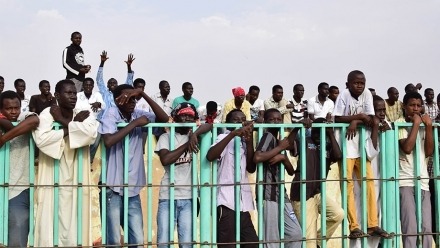Photography exhibition showcases global reach of ANU anthropology

Paul Hayes, On the outskirts of Khartoum, Sudanese migrants at a Nuba wrestling match, Sudan, 2015
Friday 22 September 2017
An ANU photo exhibition will offer insights into fieldwork conducted by ANU anthropologists all over the world.
The featured photographs, by 31 anthropologists from the College of Arts and Social Sciences and the College of Asia and the Pacific, span central Australia, to remote Tibet, to a wrestling stadium in Sudan.
Jo Thurman, a PhD candidate in the ANU School of Archaeology and Anthropology, says the images serve not only to illustrate their research but can actually communicate and represent more than what words can accomplish.
“We want to encourage an anthropological engagement in visual media and representation as well as invite visitors to engage with the discipline of anthropology,” she says.
Jo, who is one of the exhibition’s student organisers, submitted photos from her research in a Warlpiri community in central Australia. One image shows Nampijinpa, a Warlpiri woman, as she hunts goanna through the “burned grass” landscape.
“As I took the photos, I knew that in another week’s time my fieldwork would be finished,” Jo says, describing feeling something akin to nostalgia.
But, she adds: “It was a nostalgic longing for the present, in the very moment that I was experiencing it, in the knowledge that everything would soon change.”
Fellow PhD candidate Paul Hayes’ research explores the migration patterns of the Nuba people of Sudan, who have been involved in protracted armed conflict with the north Sudanese regime. Seeking safety, many Nuba people have migrated to the Sudanese capital of Khartoum.
Paul says, however, that not all the Nuba in Khartoum are there to escape the effects of the war. Some are labour migrants who travel back and forth, and yet others have remained in the Nuba mountains.
“The situation in Sudan seemed to share similarities with a couple of other anthropological studies of wartime migration in Afghanistan and Mozambique, where it is difficult to distinguish between a labour migrant and a forcibly displaced person,” he says.
“Through interviews, and extensive participant observation in the Nuba community in Khartoum, I want to get a sense of the role migration plays in people’s lives, livelihoods and identities, how decisions are made about whether and when to migrate – in wartime and in peace.”
His photos were taken at a stadium in Khartoum, where the Nuba wrestle competitively. It’s a location Paul found to be a good field site.
“These weekly wrestling matches are kind of a convenient place for a foreigner to hang out and meet lots of people, because they’re open to the public.”
Zoe Hatten’s photographs depict quite mundane scenes normally “considered unworthy of photographic attention in the highly choreographed world of weddings in China”.
Zoe, an anthropology PhD student in the ANU School of Culture, History and Languages, is looking at the way marriage and all that it encompasses – such as love, romance and family formation – are evolving in light of China’s regime of modernisation.
Modernisation has involved commercialisation and “commodification of various aspects of life to fit the patterns and demands of modern industry.”
“In China, this really began with what is known as the ‘reform era’ in 1978, when previously state controlled industry expanded to allow private entrepreneurship, and commercial interests from outside China began to exert their influence,” Zoe says.
As part of her research, she attended over 50 weddings in China.
“Sometimes, I was invited to give a speech or sing onstage to add a bit of foreign flavour to their weddings,” she says.
“I am a terrible singer and don’t really enjoy being on stage in front of people, so this was usually a disappointment.
“Overall, I was surprised by how willing and open people were in allowing me to come to their weddings and ask them strange questions.”
The Art of Anthropology exhibition will be launched on 29 September and run 2-20 October at the Australian Centre on China in the World Gallery.
This news story was originally published on the ANU College of Arts and Social Sciences website.








